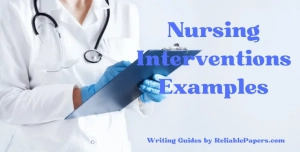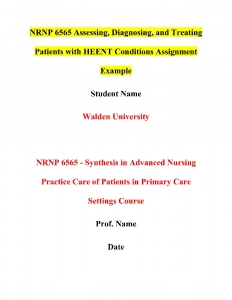Nursing Interventions Examples High-Quality Nursing Papers

Nursing interventions are evidence-based actions that the nurse performs to achieve patient outcomes. These interventions are grouped into three categories according to the role of the healthcare professional involved in the patient’s care: family nursing interventions, behavioral nursing interventions, and physiological basic nursing interventions. Examples of nursing interventions include providing physical treatments, emotional support, and patient education; administering medication; checking vital signs; and helping patients maintain their safety and preventing further injury. Nurses plan health goals for patients and detail which interventions are needed to help a patient achieve the desired outcome.
Independent Nursing Interventions Examples
Independent nursing interventions are tasks that a nurse can perform without input from another discipline, such as a physician’s order. Examples of independent nursing interventions include providing water, repositioning a patient, providing toileting assistance, and bathing.
Other independent nursing interventions include therapeutic communication to assist patients to cope with a new medical diagnosis, monitoring vital signs, and providing physical treatments, emotional support, and patient education.
Family nursing interventions, behavioral nursing interventions, community nursing interventions, and key nursing interventions to perform each shift are also examples of independent nursing interventions.
You can get more independent nursing interventions examples from the following list:
- Assessing and monitoring vital signs such as blood pressure, temperature, and heart rate.
- Administering medications, such as oral or topical medications, as per the medication administration record.
- Assessing and documenting the patient’s condition, including changes in symptoms or vital signs.
- Implementing infection control measures, such as hand hygiene and isolation precautions.
- Assisting with activities of daily living, such as bathing, dressing, and toileting.
- Assessing and managing pain, including administering pain medication and non-pharmacologic interventions.
- Assessing and managing wound care, including changing dressings, monitoring healing progress, and documenting wound care.
- Educating patients and families about their condition and treatment.
- Assessing and managing patient’s mental and emotional well-being.
- Participating in interdisciplinary teams to develop care plans and coordinate care.
Dependent Nursing Interventions Examples
Dependent nursing interventions are those that require instructions or input from a doctor, such as prescribing new medication. Examples of dependent nursing interventions include administering medication, referring to specialists, ordering diagnostic tests, and prescribing treatments.
Other examples of dependent nursing interventions include fall prevention, pain control, fluid intake, mobility therapy, assistive device therapy, and sleep pattern management.
You can get more independent nursing interventions examples from the following list:
- Administering medications, such as intravenous medications or controlled substances.
- Administering treatments, such as wound care or physical therapy, that require specific instructions or protocols.
- Performing diagnostic tests, such as drawing blood or obtaining cultures.
- Administering treatments, such as oxygen therapy or mechanical ventilation
- Administering treatments, such as enteral or parenteral nutrition
- Administering treatments, such as blood transfusions
- Administering treatments, such as administering intravenous medications
- Administering treatments, such as administering chemotherapy
- Administering treatments, such as administering radiation therapy
- Administering treatments, such as administering pain management therapy
Notably, the specific dependent nursing interventions can vary depending on the facility and state laws and regulations. Nurses should always consult their facility’s policies and procedures, as well as state laws and regulations, to determine which actions require a physician’s order.
You can get more ideas and examples for writing nursing research papers such as how to write nursing term papers or assignments from another article provided by us.
Interdependent/Collaborative Nursing Interventions Examples
Interdependent/Collaborative nursing interventions are activities that require a team of medical professionals to work together for the care and full recovery of a patient. Examples of interdependent/collaborative nursing interventions include consulting with a respiratory therapist when the patient has deteriorating oxygen saturation levels, pain control, fluid intake, mobility therapy, assistive device therapy, sleep pattern management, fall prevention, and health promotion activities such as immunizations and screenings. Nurses perform these tasks under the guidance of different disciplines and ensure communication of patient care between all parties.
You can get more interdependent/collaborative nursing interventions examples from the following list:
- Developing and implementing care plans with physicians and other members of the healthcare team
- Coordinating communication and information sharing among members of the healthcare team
- Participating in multidisciplinary rounds to discuss patient cases and treatment options
- Assisting with patient education and discharge planning
- Participating in quality improvement initiatives
- Collaborating with other healthcare professionals to provide care for patients with complex medical conditions
- Consulting with other healthcare professionals to make decisions about patient care
- Participating in case management to ensure continuity of care for patients with chronic conditions
Examples of Nursing Interventions for Specific Conditions
Nursing interventions examples for pain management may include:
- Assessing the patient’s pain level and type, including the location, duration, and intensity of the pain.
- Administering pain medication as prescribed by the physician, such as non-steroidal anti-inflammatory drugs (NSAIDs) or opioids.
- Using non-pharmacological interventions such as heat/cold therapy, massage, or relaxation techniques.
- Assisting with positioning and mobility to prevent further pain or injury.
- Educating the patient and their family about pain management and self-care techniques.
- Regularly re-assessing the patient’s pain level and adjusting interventions as necessary.
- Documenting the patient’s pain level, interventions, and response in the medical record.
- Collaborating with the interdisciplinary team to develop an individualized pain management plan.
- Referring patient to pain management specialist if needed
Nursing interventions examples for pneumonia may include:
- Administering antibiotics as prescribed by the physician.
- Assisting with breathing treatments and oxygen therapy as needed.
- Monitoring vital signs and oxygen saturation levels.
- Assisting with cough and deep-breathing exercises to help clear lung secretions.
- Educating the patient and their family about the importance of rest, fluids, and infection control measures.
- Collaborating with interdisciplinary team for any needed interventions
Nursing interventions examples for UTI may include:
- Administering antibiotics as prescribed by the physician.
- Assisting with pain relief measures such as heating pad on lower abdomen and encouraging to drink fluids.
- Educating the patient and their family about the importance of maintaining good hygiene and urinating frequently.
- Monitoring vital signs and urine output.
- Assisting with collecting urine samples for culture and sensitivity testing.
- Collaborating with interdisciplinary team for any needed interventions
Nursing interventions examples for hypertension may include:
- Assessing and monitoring blood pressure regularly.
- Assisting with lifestyle changes such as diet, exercise, and weight management.
- Administering medications as prescribed by the physician.
- Educating the patient and their family about hypertension and the importance of adhering to the treatment plan.
- Collaborating with interdisciplinary team for any needed interventions
Nursing interventions examples for anxiety may include:
- Assessing the patient’s level of anxiety and triggers.
- Administering medications as prescribed by the physician.
- Using non-pharmacological interventions such as relaxation techniques and cognitive-behavioral therapy.
- Educating the patient and their family about anxiety and coping strategies.
- Collaborating with interdisciplinary team for any needed interventions
Nursing interventions examples for hypokalemia may include:
- Assessing and monitoring potassium levels regularly.
- Administering potassium supplements as prescribed by the physician.
- Educating the patient and their family about the importance of a diet high in potassium.
- Collaborating with interdisciplinary team for any needed interventions
Nursing interventions examples for impaired gas exchange may include:
- Assessing and monitoring vital signs and oxygen saturation levels.
- Administering oxygen therapy as needed.
- Assisting with breathing treatments and cough and deep-breathing exercises.
- Educating the patient and their family about the importance of maintaining good hygiene and avoiding respiratory irritants.
- Collaborating with interdisciplinary team for any needed interventions
Nursing interventions examples for acetaminophen overdose may include:
- Assessing the patient’s vital signs, history of medication use, and potential for overdose.
- Administering the appropriate treatment, such as activated charcoal or N-acetylcysteine (NAC), as prescribed by the physician.
- Monitoring liver function tests and blood glucose levels.
- Educating the patient and their family about the dangers of acetaminophen overdose and safe medication use.
- Collaborating with interdisciplinary team for any needed interventions
Nursing interventions examples for CHF (Congestive Heart Failure) may include:
- Assessing and monitoring vital signs, fluid balance, and cardiac function.
- Administering medications as prescribed by the physician, such as diuretics, ACE inhibitors, and beta-blockers.
- Assisting with lifestyle changes such as diet, exercise, and weight management.
- Educating the patient and their family about CHF and the importance of adhering to the treatment plan.
- Collaborating with interdisciplinary team for any needed interventions
Nursing interventions examples for sepsis may include:
- Assessing and monitoring vital signs and signs of infection.
- Administering antibiotics as prescribed by the physician.
- Assisting with fluid and electrolyte replacement therapy as needed.
- Monitoring for and managing any organ dysfunction or failure.
- Educating the patient and their family about sepsis and the importance of early recognition and treatment.
- Collaborating with interdisciplinary team for any needed interventions
Nursing interventions examples for COPD (Chronic Obstructive Pulmonary Disease) may include:
- Assessing and monitoring vital signs, lung function, and oxygen saturation levels.
- Administering bronchodilators and corticosteroids as prescribed by the physician.
- Assisting with breathing treatments and cough and deep-breathing exercises.
- Educating the patient and their family about COPD and the importance of maintaining good hygiene and avoiding respiratory irritants.
- Collaborating with interdisciplinary team for any needed interventions
Nursing interventions examples for dementia may include:
- Assessing and monitoring the patient’s cognitive status and level of function.
- Assisting with activities of daily living and providing a safe environment.
- Educating the patient and their family about dementia and strategies for managing behaviors and communication.
- Collaborating with interdisciplinary team for any needed interventions
Nursing interventions examples for chest pain may include:
- Assessing the patient’s vital signs, history of chest pain, and potential causes.
- Administering medications as prescribed by the physician, such as nitroglycerin or heparin.
- Monitoring for and managing any cardiac complications.
- Educating the patient and their family about chest pain and the importance of seeking prompt medical attention.
- Collaborating with interdisciplinary team for any needed interventions
Nursing interventions examples for aspirin overdose may include:
- Assessing the patient’s vital signs, history of medication use, and potential for overdose.
- Administering the appropriate treatment, such as activated charcoal or oral acetylcysteine, as prescribed by the physician.
- Monitoring blood glucose levels, blood clotting times, and blood pH levels.
- Educating the patient and their family about the dangers of aspirin overdose and safe medication use.
- Collaborating with interdisciplinary team for any needed interventions
Nursing interventions examples for depression may include:
- Assessing the patient’s mood, level of functioning, and potential causes of depression.
- Administering medications as prescribed by the physician, such as antidepressants.
- Using non-pharmacological interventions such as cognitive-behavioral therapy or talk therapy.
- Educating the patient and their family about depression and strategies for managing symptoms and improving overall well-being.
- Collaborating with interdisciplinary team for any needed interventions
Nursing interventions examples for infection may include:
- Assessing and monitoring the patient’s vital signs, wound, and potential sources of infection.
- Administering antibiotics as prescribed by the physician.
- Assisting with wound care and infection control measures.
- Educating the patient and their family about infection prevention and the importance of adhering to the treatment plan.
- Collaborating with interdisciplinary team for any needed interventions
Nursing interventions examples for postpartum hemorrhage may include:
- Assessing and monitoring vital signs and blood loss.
- Administering medications as prescribed by the physician, such as oxytocin or misoprostol.
- Assisting with uterine massage to promote uterine contractions and prevent bleeding.
- Educating the patient and their family about postpartum hemorrhage and the importance of seeking prompt medical attention.
- Collaborating with interdisciplinary team for any needed interventions
Nursing interventions examples for stroke may include:
- Assessing and monitoring the patient’s level of consciousness, motor function, and potential causes of stroke.
- Administering medications as prescribed by the physician, such as tPA or anticoagulants.
- Assisting with physical and occupational therapy to promote recovery and prevent further injury.
- Educating the patient and their family about stroke and the importance of adhering to the treatment plan.
- Collaborating with interdisciplinary team for any needed interventions
Nursing interventions examples for DKA (Diabetic Ketoacidosis) may include:
- Assessing and monitoring blood glucose levels, electrolyte levels, and acid-base balance.
- Administering fluids and electrolytes as prescribed by the physician.
- Administering insulin as prescribed by the physician.
- Educating the patient and their family about DKA and the importance of adhering to the treatment plan.
- Collaborating with interdisciplinary team for any needed interventions
Nursing interventions examples for atrial fibrillation (A-fib) may include:
- Assessing and monitoring vital signs, cardiac function, and potential causes of atrial fibrillation.
- Administering medications as prescribed by the physician, such as beta-blockers, ACE inhibitors, and anticoagulants.
- Educating the patient and their family about atrial fibrillation such as the treatment options, and potential complications and the importance of adhering to the treatment plan.
- Assessing the patient’s risk for stroke and implementing appropriate interventions
- Coordinating with other healthcare providers for comprehensive care, including surgical intervention if necessary
Nursing interventions examples for diabetes may include:
- Assessing and monitoring blood glucose levels, diet, and exercise.
- Assisting the patient with insulin administration or oral hypoglycemic agents as prescribed by the physician.
- Educating and assisting the patient with lifestyle changes such as diet, exercise, and weight management.
- Educating the patient and their family about diabetes and the importance of adhering to the treatment plan.
- Monitoring for and managing complications such as diabetic neuropathy and nephropathy
- Collaborating with interdisciplinary team for any needed interventions
Nursing interventions examples for cellulitis may include:
- Assessing and monitoring the patient’s vital signs, signs of infection, and potential sources of cellulitis.
- Administering antibiotics as prescribed by the physician.
- Assisting with wound care and infection control measures.
- Educating the patient and their family about cellulitis and the importance of adhering to the treatment plan and maintaining good hygiene.
- Collaborating with interdisciplinary team for any needed interventions
Nursing interventions examples for decreased cardiac output may include:
- Assessing and monitoring vital signs, cardiac function, and potential causes of decreased cardiac output.
- Administering medications as prescribed by the physician, such as inotropes or vasodilators.
- Assisting with fluid and electrolyte replacement therapy as needed.
- Educating the patient and their family about decreased cardiac output and the importance of adhering to the treatment plan.
- Collaborating with interdisciplinary team for any needed interventions
Nursing interventions examples for hyperkalemia may include:
- Assessing and monitoring potassium levels, ECG, and potential causes of hyperkalemia.
- Administering potassium-binding resins or potassium-lowering medications as prescribed by the physician.
- Administering glucose and insulin as prescribed by the physician.
- Educating the patient and their family about hyperkalemia and the importance of adhering to the treatment plan.
- Collaborating with interdisciplinary team for any needed interventions
Nursing interventions examples for constipation may include:
- Assessing the patient’s dietary intake, fluid intake, and bowel movements.
- Administering laxatives or enemas as prescribed by the physician.
- Assisting with bowel retraining and the use of a toilet schedule.
- Educating the patient and their family about constipation and the importance of a high-fiber diet and regular physical activity.
- Collaborating with interdisciplinary team for any needed interventions
Nursing interventions examples for GI bleed may include:
- Assessing and monitoring vital signs, fluid balance, and potential causes of GI bleed.
- Administering medications as prescribed by the physician, such as proton pump inhibitors or anticoagulants.
- Assisting with fluid and blood replacement therapy as needed.
- Educating the patient and their family about GI bleed and the importance of adhering to the treatment plan.
- Collaborating with interdisciplinary team for any needed interventions
Nursing interventions examples for bipolar disorder may include:
- Assessing the patient’s mood, level of functioning, and potential triggers of manic or depressive episodes.
- Administering medications as prescribed by the physician, such as mood stabilizers or antidepressants.
- Using non-pharmacological interventions such as talk therapy or family therapy.
- Educating the patient and their family about bipolar disorder and strategies for managing symptoms and preventing episodes.
- Collaborating with interdisciplinary team for any needed interventions
Nursing interventions examples for impaired skin integrity may include:
- Assessing and documenting the affected area, including size, location, and stage of wound
- Cleaning and dressing the wound as appropriate
- Monitoring for signs of infection
- Educating the patient and their family on proper wound care
- Referring the patient to a wound specialist as needed
Nursing interventions examples for pancreatitis may include:
- Assessing and monitoring the patient’s vital signs, including blood pressure and heart rate
- Assessing and monitoring the patient’s abdominal pain
- Administering pain medication as appropriate
- Educating the patient on proper diet and avoiding triggers of pancreatitis
- Monitoring for and managing complications such as sepsis and organ failure
Nursing interventions examples for dehydration may include:
- Assessing and monitoring the patient’s fluid intake and output
- Administering fluids, either orally or intravenously, as needed
- Educating the patient on the importance of proper hydration and strategies for maintaining hydration
- Monitoring for signs of electrolyte imbalances
- Coordinating with other healthcare providers as needed for comprehensive care
Nursing interventions examples for schizophrenia may include:
- Assessing and monitoring the patient’s symptoms and mental status
- Administering medication as prescribed
- Educating the patient and their family about the disease and treatment options
- Facilitating therapy sessions and support groups for the patient
- Monitoring for and managing potential side effects of medication
Nursing interventions examples for hypotension may include:
- Assessing and monitoring the patient’s vital signs, including blood pressure and heart rate
- Administering medications as prescribed to raise blood pressure
- Assisting the patient in changing positions to promote blood flow
- Educating the patient on strategies to prevent hypotension
- Monitoring for and managing potential complications such as shock or organ failure
Nursing interventions examples for autonomic dysreflexia may include:
- Assessing and monitoring the patient’s vital signs, including blood pressure and heart rate
- Identifying and addressing the trigger of the episode (such as a full bladder or bowel)
- Administering medication as prescribed to lower blood pressure
- Educating the patient and their family about the disease and strategies to prevent episodes
- Monitoring for and managing potential complications such as stroke or seizures.
Nursing interventions examples for wound care may include:
- Assessing and documenting the wound, including size, location, and stage of healing
- Cleaning and dressing the wound as appropriate
- Administering wound care medications as prescribed
- Monitoring for signs of infection
- Educating the patient and their family on proper wound care and signs of complications
Nursing interventions examples for diarrhea may include:
- Assessing and monitoring the patient’s fluid and electrolyte balance
- Administering oral rehydration solutions or intravenous fluids as needed
- Administering medications to control diarrhea as prescribed
- Educating the patient on proper diet and hygiene to prevent the spread of infection
- Monitoring for signs of dehydration or other complications
Nursing interventions examples for edema may include:
- Assessing and monitoring the patient’s fluid and electrolyte balance
- Assessing and monitoring the affected limb or body part for size, temperature, and sensation
- Administering medications to reduce edema as prescribed
- Elevating the affected limb or body part as appropriate
- Educating the patient on strategies to reduce edema, such as exercise and compression garments
Nursing interventions examples for fall risk may include:
- Assessing and identifying the patient’s fall risk factors
- Implementing fall prevention strategies, such as bed alarms and assistive devices
- Educating the patient and their family on fall prevention strategies
- Assisting the patient with mobility as needed
- Monitoring the patient’s response to fall prevention interventions and making adjustments as necessary
Nursing interventions examples for appendicitis may include:
- Assessing and monitoring the patient’s vital signs, including temperature and white blood cell count
- Administering pain medication as appropriate
- Assisting with diagnostic procedures, such as CT scans or ultrasound
- Educating the patient and their family on the disease, treatment options, and potential complications
- Coordinating with other healthcare providers for comprehensive care, including surgical intervention if necessary
Nursing interventions examples for impaired physical mobility may include:
- Assessing and identifying the patient’s mobility limitations
- Implementing strategies to improve mobility, such as physical therapy or assistive devices
- Educating the patient and their family on strategies to promote mobility and independence
- Assisting the patient with mobility as needed
- Monitoring the patient’s response to interventions and making adjustments as necessary
Nursing interventions examples for asthma may include:
- Assessing and monitoring the patient’s respiratory status, including breathing rate, oxygen saturation, and peak flow
- Administering bronchodilators and other medications as prescribed
- Educating the patient and their family on proper use of inhalers and recognition of early warning signs of an asthma attack
- Assisting with developing a plan of care and teaching the patient to manage their asthma
- Monitoring for and managing potential complications such as respiratory failure or pneumonia
Nursing interventions examples for pressure ulcers may include:
- Assessing and documenting the wound, including size, location, and stage of healing
- Implementing strategies to prevent pressure ulcers, such as turning and repositioning the patient
- Cleaning and dressing the wound as appropriate
- Administering wound care medications as prescribed
- Educating the patient and their family on proper wound care and signs of complications
Nursing interventions examples for myocardial infarction may include:
- Assessing and monitoring the patient’s vital signs, including blood pressure, heart rate, and oxygen saturation
- Administering medication as prescribed, including thrombolytics and anti-platelet agents
- Assisting with diagnostic tests, such as ECG and cardiac enzymes
- Educating the patient and their family on the disease, treatment options, and potential complications
- Coordinating with other healthcare providers for comprehensive care, including surgical intervention if necessary
Nursing interventions examples for activity intolerance may include:
- Assessing and identifying the patient’s activity level and limitations
- Developing a plan of care to promote activity and increase tolerance, such as physical therapy and exercise
- Educating the patient and their family on strategies to promote activity and independence
- Assisting the patient with mobility as needed
- Monitoring the patient’s response to interventions and making adjustments as necessary
Nursing interventions examples for anemia may include:
- Assessing and monitoring the patient’s hemoglobin and hematocrit levels
- Administering iron supplements, blood transfusions, or other treatments as prescribed
- Educating the patient and their family on the disease, treatment options, and potential complications
- Assessing the patient’s dietary intake and making recommendations for iron-rich foods
- Monitoring for and managing potential complications such as fatigue and heart failure
Nursing interventions examples for fatigue may include:
- Assessing and identifying the cause of fatigue
- Developing a plan of care to promote rest and increase energy, such as sleep hygiene and exercise
- Educating the patient and their family on strategies to manage fatigue
- Assessing the patient’s dietary intake and making recommendations for healthy foods
- Monitoring for and managing potential complications such as depression and anemia.
Nursing interventions examples for DVT may include:
- Assessing and monitoring the patient’s vital signs, including blood pressure, heart rate, and oxygen saturation
- Administering medication as prescribed, including anticoagulants
- Assisting with diagnostic tests, such as D-dimer or ultrasound
- Educating the patient and their family on the disease, treatment options, and potential complications
- Coordinating with other healthcare providers for comprehensive care, including compression stockings and physical therapy
- Monitoring for signs of complication such as bleeding, or signs of the DVT progressing to a PE.
Nursing interventions examples for Parkinson’s disease may include:
- Assessing and monitoring the patient’s motor symptoms, including tremors, rigidity, and bradykinesia
- Administering medication as prescribed, including levodopa and dopamine agonists
- Educating the patient and their family on the disease, treatment options, and potential complications
- Assisting with physical therapy and exercise to maintain mobility and independence
- Monitoring for and managing potential complications such as falls, freezing and speech difficulty
Nursing interventions examples for thrombocytopenia may include:
- Assessing and monitoring the patient’s platelet count and bleeding symptoms
- Administering platelet transfusions or other treatments as prescribed
- Educating the patient and their family on the disease, treatment options, and potential complications
- Assessing the patient’s risk for bleeding and implementing appropriate interventions
- Monitoring for and managing potential complications such as bleeding and anemia
Nursing interventions examples for placenta previa may include:
- Assessing and monitoring the patient’s vital signs, including blood pressure, fetal heart rate, and contractions
- Administering medications as prescribed to prevent preterm labor
- Educating the patient and their family on the disease, treatment options, and potential complications
- Assessing the patient’s risk for bleeding and implementing appropriate interventions
- Coordinating with other healthcare providers for comprehensive care, including surgical intervention if necessary
Nursing interventions examples for autonomic dysreflexia may include:
- Assessing and monitoring the patient’s vital signs, including blood pressure and heart rate
- Identifying and addressing the trigger of the episode (such as a full bladder or bowel)
- Administering medication as prescribed to lower blood pressure
- Educating the patient and their family about the disease and strategies to prevent episodes
- Monitoring for and managing potential complications such as stroke or seizures
Nursing interventions examples for hypovolemic shock may include:
- Assessing and monitoring the patient’s vital signs, including blood pressure, heart rate, and urine output
- Administering fluids, either orally or intravenously, as needed
- Administering medications as prescribed to increase blood pressure and heart rate
- Educating the patient and their family on the disease, treatment options, and potential complications
- Monitoring for and managing potential complications such as organ failure and sepsis.
Nursing interventions examples for pulmonary embolism may include:
- Assessing and monitoring the patient’s vital signs, including blood pressure, heart rate, and oxygen saturation
- Administering medication as prescribed, including anticoagulants and thrombolytics
- Assisting with diagnostic tests, such as CT scan or V/Q scan
- Educating the patient and their family on the disease, treatment options, and potential complications
- Coordinating with other healthcare providers for comprehensive care, including surgical intervention if necessary
Nursing interventions examples for hyponatremia may include:
- Assessing and monitoring the patient’s electrolyte levels, including sodium
- Administering fluids and electrolyte solutions as needed
- Administering medications as prescribed to correct electrolyte imbalances
- Educating the patient and their family on the disease, treatment options, and potential complications
- Monitoring for and managing potential complications such as seizures or brain swelling
Nursing interventions examples for late decelerations may include:
- Assessing and monitoring the patient’s vital signs, including blood pressure, heart rate, and fetal heart rate
- Assessing the patient’s contractions and cervical dilation
- Administering oxygen as needed
- Educating the patient and their family on the disease, treatment options, and potential complications
- Coordinating with other healthcare providers for comprehensive care, including delivery if necessary
Evaluation of Nursing Interventions Examples
Evaluation of nursing interventions involves assessing the effectiveness of the interventions in meeting the patient’s goals and making any necessary adjustments to the plan of care. This involves comparing the patient’s behavioral responses to predetermined goals and objectives. Evaluation is an important part of the nursing process, which consists of five steps: assessment, diagnosis, planning, implementation, and evaluation.
Examples of methods for evaluating nursing interventions include:
- Measuring changes in vital signs: Before and after the intervention, the nurse can measure the patient’s vital signs (blood pressure, heart rate, temperature, etc.) to determine if there is any improvement.
- Assessing patient’s symptoms: The nurse can ask the patient about their symptoms and compare the patient’s responses before and after the intervention to determine if there has been an improvement.
- Tracking patient’s progress: The nurse can use a tool such as a flow sheet to track the patient’s progress over time and monitor for any changes.
- Reviewing laboratory results: The nurse can review the patient’s laboratory results (such as blood work) to determine if the intervention has had an effect on the patient’s health.
- Patient’s feedback: The nurse can ask the patient and their family for feedback on the interventions and their satisfaction with the care provided.
- Comparing outcomes with standards: The nurse can compare the patient’s outcomes with established standards for care to determine if the interventions were effective.
The evaluation of nursing interventions should be ongoing, and the results should be shared with the healthcare team to make adjustments to the plan of care as needed.
Nursing Interventions Examples General Considerations
General considerations for nursing interventions include assessing the patient’s needs and developing a plan of care, collaborating with other members of the healthcare team, and evaluating the effectiveness of the interventions.
It is also important to consider the patient’s cultural and personal beliefs, as well as any potential risks or side effects of the interventions.
Communication with the patient and their family is also a key consideration to ensure that the patient is informed and involved in their care.
Get Expert Help with Writing Your Nursing Interventions Paper
Whenever you feel stuck while writing your nursing intervention paper or assignment, you can always turn to experts for reliable paper writing services. Our expert writers will deliver to you a custom nursing paper of the highest grade that will ensure you get top grades.
It is important to remember that writing a nursing interventions paper requires research, critical thinking, and attention to detail. It may take some time and effort, but with proper planning and execution, and the help of our experts you will produce a well-written and informative paper.
Finding a skilled professional with clinical experience in various diseases is crucial when looking for nursing intervention paper help. This will guarantee successful and timely assignment completion.
Write your paper from scratch or have it edited and proofread by professionals at ReliablePapers.com.
Our company is known for helping students do their nursing assignments on time and for a fair price.
Hire an Expert Paper Writer on Any Subject, Any Topic, Any Deadline! Submit your paper instructions by placing your order here to get started!










 Assignment 2: Assessing, Diagnosing, and Treating Patients with HEENT Conditions
Assignment 2: Assessing, Diagnosing, and Treating Patients with HEENT Conditions